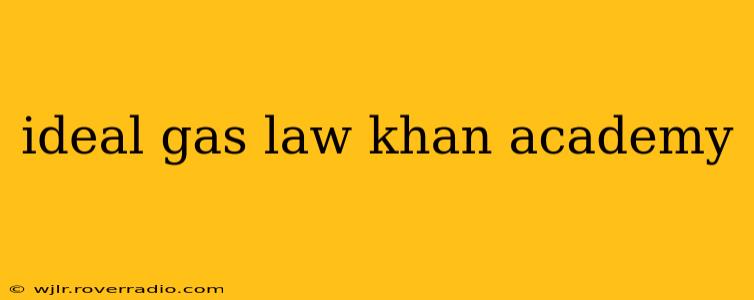The Ideal Gas Law is a cornerstone of chemistry and physics, providing a simple yet powerful way to understand the behavior of gases under various conditions. While Khan Academy offers excellent resources for learning this concept, this article delves deeper, offering a more comprehensive understanding and addressing common questions students often have. We'll explore the law itself, its applications, and some of its limitations.
What is the Ideal Gas Law?
The Ideal Gas Law is a mathematical relationship that describes the behavior of an ideal gas. An ideal gas is a theoretical gas composed of randomly moving point particles that do not interact except during perfectly elastic collisions. While no real gas perfectly behaves like an ideal gas, many gases behave approximately ideally under certain conditions (low pressure and high temperature).
The law is expressed as:
PV = nRT
Where:
- P represents pressure (typically in atmospheres, atm, or Pascals, Pa)
- V represents volume (typically in liters, L, or cubic meters, m³)
- n represents the number of moles of gas
- R is the ideal gas constant (its value depends on the units used for pressure and volume; a common value is 0.0821 L·atm/mol·K)
- T represents temperature (always in Kelvin, K)
How do I use the Ideal Gas Law to solve problems?
The Ideal Gas Law allows you to calculate any of the variables (P, V, n, T) if you know the values of the other three. Let's look at an example:
Example: If you have 2 moles of a gas at a temperature of 298 K and a pressure of 1 atm, what is the volume of the gas?
Using the Ideal Gas Law (PV = nRT):
V = nRT/P = (2 mol)(0.0821 L·atm/mol·K)(298 K) / (1 atm) ≈ 48.9 L
The volume of the gas is approximately 48.9 liters.
Remember to always use consistent units! If you are given pressure in kPa, you'll need to use the appropriate value for R and convert other units as needed.
What are the assumptions of the Ideal Gas Law?
The Ideal Gas Law relies on several key assumptions about the gas particles, which is why real gases don't always perfectly obey it:
- Particles have negligible volume: This means the volume of the gas particles themselves is insignificant compared to the volume of the container.
- No intermolecular forces: This means the particles do not attract or repel each other.
- Collisions are perfectly elastic: This means no energy is lost during collisions between particles or with the container walls.
- Particles are in constant, random motion: This contributes to the pressure exerted by the gas.
When does the Ideal Gas Law fail?
The Ideal Gas Law is a good approximation at low pressures and high temperatures. However, it begins to deviate significantly from real gas behavior under conditions of:
- High pressure: At high pressures, the volume of the gas particles becomes a significant fraction of the total volume.
- Low temperature: At low temperatures, intermolecular forces become more significant, affecting particle interactions.
What are some real-world applications of the Ideal Gas Law?
The Ideal Gas Law has numerous applications in various fields, including:
- Automotive engineering: Designing and optimizing engines, including fuel efficiency calculations.
- Meteorology: Predicting weather patterns by analyzing atmospheric pressure, temperature, and humidity.
- Aerospace engineering: Designing aircraft and spacecraft, including considerations of altitude and pressure changes.
- Chemical engineering: Designing and operating chemical processes involving gases.
How does the Ideal Gas Law relate to other gas laws?
The Ideal Gas Law can be considered a combination of several other gas laws, including:
- Boyle's Law: Pressure and volume are inversely proportional at constant temperature and moles (P1V1 = P2V2).
- Charles's Law: Volume and temperature are directly proportional at constant pressure and moles (V1/T1 = V2/T2).
- Avogadro's Law: Volume and number of moles are directly proportional at constant pressure and temperature (V1/n1 = V2/n2).
What are some common mistakes when using the Ideal Gas Law?
- Incorrect unit conversions: Always ensure you are using consistent units for all variables.
- Forgetting to convert Celsius to Kelvin: Temperature must always be in Kelvin.
- Misunderstanding the assumptions of the Ideal Gas Law: Knowing the limitations of the law is essential for accurate predictions.
This expanded explanation provides a more thorough understanding of the Ideal Gas Law than a simple Khan Academy overview. Remember that mastering this concept requires practice and problem-solving. By understanding its principles and limitations, you can apply this crucial tool in various scientific contexts.
